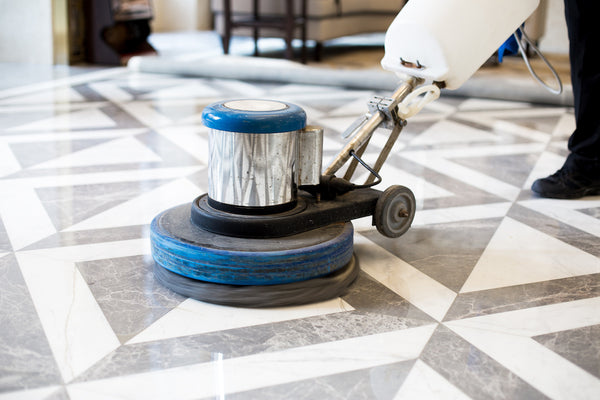
A floor polisher machine is sometimes referred to as a floor buffer. Its job is to keep floor surfaces clean and shiny. To operate one effectively, you must first learn the proper way to hold the machine, how to move it from side to side, the basic safety protocols involved, and how to safely store it after each use.
Using a floor polisher is not difficult. However, since it’s becoming more of a basic household appliance, few people know how to use it properly.
This guide walks you through the simple process of using a floor polisher machine. It touches on points like the correct posture, keeping the buffer level with the floor, the right way to store it, and more.
Getting Started
The first step is attaching the pad (or brush) to the rotating disc at the bottom of the polisher. To access it, you’ll first need to lock in the buffer’s handle in an upright position. Doing this allows you to lay it down horizontally against the handle to expose the bottom side. Installing the brush or pad is usually a two-second job. Some floor buffers have sticky, Velcro-like discs that quickly accept attachments.
Once the brush is installed and the machine is upright once more, you can go ahead and plug it in.
How To Hold A Floor Polisher
This next step is crucial. It involves holding the floor polisher the right way. Floor polishers are typically heavy machines. They can easily weigh over 200 pounds. They can slip and get away from you if you don’t grip them firmly. That’s why it’s a good idea to invest in a floor polisher machine with directional wheels. It is much easier to use and transport.
In any case, here is the right way to hold a polisher machine.
First, hold the handle with both hands, then drop your hands to about waist level. You want them to hang comfortably at your sides while operating the floor buffer.
Keeping them hoisted will result in fatigue and aches, so try to extend them to a comfortable position before you begin working. Also, you should know that floor polishers are mainly controlled by lifting and lowering the handle. That means if you start with a high handle position, you’ll have trouble navigating towards one direction.
That brings us to the next step.
Controlling A Floor Polisher
Most floor buffer machines have straightforward controls. The motor is powered by levers on either side of the handle, whereas the handle rod controls the machine’s lateral movement.
To make the machine move right, you lift the handle rod, and to glide it towards the left, you lower it back down. Keeping the handle rod in a neutral position will center the polisher.
The size of the brush dictates the polisher’s cleaning capacity. If it’s 17 inches in diameter, for instance, then you can clean 17-inch swathes of the floor in both directions.
Stopping Suddenly
At one point, especially when you’re new to polishing floors, you may have to stop operations abruptly to prevent the machine from wheeling away.
Some polishers weigh hundreds of pounds, so it’s usually not safe to get in their way when they spin out of control. The safest way to stop a runaway polisher machine is by letting go of the throttle immediately. Remember, the motor won’t work unless you hold the levers. That’s why letting go immediately is the quickest way to kill its momentum.
The Right Way to Store It
Before wheeling the polisher back to the storage shed, first remove the brush or buffering pad. As we’ve seen, these are heavy machines, and subjecting the delicate brushes and pads to hundreds of pounds of weight for hours, days, or weeks will flatten some of their sides.
When that happens, the movement of the polisher becomes highly irregular. Uneven contact with the floor will lead to it vibrating uncontrollably during operation, which can be dangerous.
Always store the pads and brushes separately from the machine.
Tips for extra safety and effectiveness
- When polishing, start at the wall farthest to the door
- Always work towards the center of the floor, not away from it
- Directional wheels give better access to tight spaces
- Always clean the polishing pads and brushes after each use